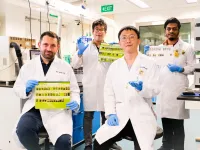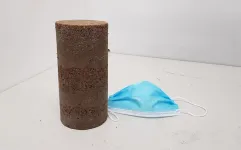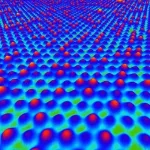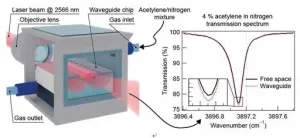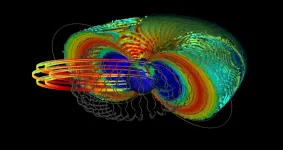(Press-News.org) A team from Nanyang Technological University, Singapore (NTU Singapore) has developed a portable device that produces high-resolution 3D images of human skin within 10 minutes.
The team said the portable skin mapping (imaging) device could be used to assess the severity of skin conditions, such as eczema and psoriasis.
3D skin mapping could be useful to clinicians, as most equipment used to assess skin conditions only provide 2D images of the skin surface. As the device also maps out the depth of the ridges and grooves of the skin at up to 2mm, it could also help with monitoring wound healing.
The device presses a specially devised film onto the subject's skin to obtain an imprint of up to 5 by 5 centimetres, which is then subjected to an electric charge, generating a 3D image.
The researchers designed and 3D printed a prototype of their device using polylactic acid (PLA), a biodegradable bioplastic. The battery-operated device which measures 7cm by 10cm weighs only 100 grams (See Image 1)
The made-in-NTU prototype is developed at a fraction of the cost of devices with comparable technologies, such as optical coherence tomography (OCT) machines, which may cost thousands of dollars and weigh up to 30 kilogrammes.
Assistant Professor Grzegorz Lisak from NTU's School of Civil and Environmental Engineering, who led the research, said: "Our non-invasive, simple and inexpensive device could be used to complement current methods of diagnosing and treating skin diseases. In rural areas that do not have ready access to healthcare, non-medically trained personnel can make skin maps using the device and send them to physicians for assessment."
Providing an independent comment on how the device may be useful to clinicians, Dr Yew Yik Weng, a Consultant Dermatologist at the National Skin Centre and an Assistant Professor at NTU's Lee Kong Chian School of Medicine, said: "The technology is an interesting way to map the surface texture of human skin. It could be a useful method to map skin texture and wound healing in a 3D manner, which is especially important in research and clinical trials. As the device is battery-operated and portable, there is a lot of potential in its development into a tool for point of care assessment in clinical settings."
Asst Prof Dr Yew added: "The device could be especially useful in studies involving wound healing, as we are currently lacking a tool that maps the length and the depth of skin ridges. Currently, we rely on photographs or measurements in our trials which could only provide a 2D assessment."
First author of the study, Mr Fu Xiaoxu, a PhD student from NTU's School of Civil and Environmental Engineering, said: "The 3D skin mapping device is simple to operate. On top of that, a 1.5V dry battery is all that is necessary to run the device. It is an example of a basic, yet very effective application of electrochemistry, as no expensive electronic hardware is required."
Published in the scientific journal Analytica Chimica Acta this month, the technology was developed by Asst Prof Lisak, who is also Director of Residues & Resource Reclamation Centre at the Nanyang Environment and Water Research Institute (NEWRI) and his PhD student, Mr Fu Xiaoxu.
The 'golden' solution to 3D skin mapping
The key component of the NTU device is a polymer called PEDOT:PSS , commonly used in solar panels to convert light into electricity. However, the team found a different use for its electrical conductivity - to reproduce skin patterns on gold-coated film. Gold is used as it has excellent electrical conductivity and flexibility.
To use the device, a person pushes a button to press the gold-coated film onto the subject's skin to obtain an imprint. This causes sebum, an oily substance produced by the skin, to be transferred onto the film, creating an imprint of the skin surface (see video).
Next, the imprint of the skin is transferred to the portable device where a set of electrodes is immersed in a solution. With another push of a button, the device triggers a flow of electric charge, causing PEDOT:PSS to be deposited on the surfaces of the gold-coated film in areas that are not covered with sebum. This results in a high-resolution 3D map of the skin, which reflects the ridges and grooves of the subject's skin.
Using pig skin as a model, the researchers demonstrated that the technology was able to map the pattern of various wounds such as punctures, lacerations, abrasions, and incisions.
The team also showed that even the complex network of wrinkles on the back of a human hand could be captured on the film. The thin film is also flexible enough to map features on uneven skin areas, such as the creases of an elbow and fingerprints.
Asst Prof Lisak added: "The device has also proven to be effective in lifting fingerprints and gives a high-resolution 3D image of their characteristics." (See Image 2)
Commenting on the potential uses of the device, Asst Prof Dr Yew added: "The device may aid in fingerprint identification, which is commonly performed in forensic analysis. The device could offer a higher degree of accuracy when it comes to differentiating between similar prints, due to the 3D nature of its imagery."
To further validate its efficacy, the team is exploring conducting clinical trials later this year to test the feasibility of their device, as well as other potential therapeutic uses.
INFORMATION:
A satellite-based dataset generated by KAUST researchers has revealed the dynamics of dust storm formation and movements over the last decade in the Arabian Peninsula. Analysis of this long-term dataset reveals the connection between the occurrence of extreme dust events and regional atmospheric conditions, a finding that could help improve weather forecasting and air-quality models.
Dust storms occur when strong winds lift tiny particles of sand into the atmosphere. These events often span several miles and can have an enormous impact on daily life, from damaging buildings and disrupting air traffic to triggering respiratory illnesses and other health problems.
The Arabian Peninsula is a global hotspot of extreme dust events, with storms occurring ...
Residential gardens are a poor substitute for native bushland and increasing urbanisation is a growing threat when it comes to bees, Curtin University research has found.
Published in 'Urban Ecosystems', the research looked at bee visits to flowers, which form pollination networks across different native bushland and home garden habitats.
Lead author, Forrest Foundation Scholar Miss Kit Prendergast, from Curtin's School of Molecular and Life Sciences said the findings highlight the need to prevent destruction of remaining bushland and preserve native vegetation, in order to protect sustainable bee communities and their pollination services.
"Our study involved spending hundreds of hours at 14 sites on the Swan Coastal Plain at Perth, Western Australia, ...
Researchers have shown how disposable face masks could be recycled to make roads, in a circular economy solution to pandemic-generated waste.
Their study shows that using the recycled face mask material to make just one kilometre of a two-lane road would use up about 3 million masks, preventing 93 tonnes of waste from going to landfill.
Developed by researchers at RMIT University in Melbourne, Australia, the new road-making material is a mix of shredded single-use face masks and processed building rubble designed to meet civil engineering safety standards. ...
Researchers from Peter the Great St.Petersburg Polytechnic University (SPbPU) in collaboration with colleagues from Belgium take a step in the development of genome editing technology. Currently it is possible to deliver genetic material of different sizes and structures to organs and tissues. This is the key to eliminating DNA defects and treating more patients. The project is guided by Professor Gleb Sukhorukov and supported by the Russian Science Foundation. Research results were published in Particle & Particle Systems Characterization journal.
An international research group developed a polymer ...
Semiconducting 2D alloys could be key to overcoming the technical limitations of modern electronics. Although 2D Si-Ge alloys would have interesting properties for this purpose, they were only predicted theoretically. Now, scientists from Japan Advanced Institute of Science and Technology have realized the first experimental demonstration. They have also shown that the Si to Ge ratio can be adjusted to fine tune the electronic properties of the alloys, paving the way for novel applications.
Alloys--materials composed of a combination of different elements or compounds--have played a crucial role in the technological development of humans since the Bronze Age. Today, ...
The Bronze Age (2200 to 800 BC) marked a decisive step in the technological and economic development of ancient societies. People living at the time faced a series of challenges: changes in the climate, the opening up of trade and a degree of population growth. How did they respond to changes in their diet, especially in Western Switzerland? A team from the University of Geneva (UNIGE), Switzerland, and Pompeu Fabra University (UPF) in Spain has for the first time carried out isotopic analyses on human and animal skeletons together with plant remains. The scientists discovered that manure use had become widespread over time to improve crop harvests in response to demographic growth. The researchers also found that there had ...
Optical waveguides suspended in air are capable to beat free-space laser beams in light-analyte interaction even without complex dispersion engineering. This phenomenon has been predicted more than 20 years ago, yet never observed in experiment.
In a new paper published in Light Science & Application, a team of scientists, led by Professor Jana Jágerská from Department of Science and Technology, UiT The Arctic University of Norway, and co-workers have devised a mid-infrared free standing solid core optical waveguide which pushes the light interaction with the surrounding air beyond what has been reported up until now: 107 % interaction strength compared to that of a free-space beam has been demonstrated.
"The guided mode of our thin waveguide ...
New study found that electrons can reach ultra-relativistic energies for very special conditions in the magnetosphere when space is devoid of plasma.
Recent measurements from NASA's Van Allen Probes spacecraft showed that electrons can reach ultra-relativistic energies flying at almost the speed of light. Hayley Allison, Yuri Shprits and collaborators from the German Research Centre for Geosciences have revealed under which conditions such strong accelerations occur. They had already demonstrated in 2020 that during solar storm plasma waves play a crucial role for that. However, it was previously unclear why such high electron energies are not achieved ...
The COVID-19 pandemic has upended many parts of daily life, one of them being our work life. Research carried out by the Universitat Oberta de Catalunya (UOC) has studied the factors that help make efficient work teams. The explanation is multidimensional and multilevel.
"Inspiring leadership builds employees' resilience and willingness to undertake new challenges," said Pilar Ficapal Cusi, professor at the UOC's Faculty of Economics and Business and one of the authors of the study, which was published in the Journal of Cleaner Production.
Viewed from the group and organizational perspective, "the shared vision, the team's belief in its own creative effectiveness, the ability to reflect openly about how their members connect to adapt ...
Researchers at Lund University in Sweden have discovered the individual traits of fungi, and how their hyphae - that is, the fungal threads that grow in soil - behave very differently as they navigate through the earth's microscopic labyrinths.
The study was performed in a lab environment, and the underground system constructed synthetically from silicone. Using a microscope, researchers were able to follow seven species and compare their behaviour. How do they react when the maze they grow in turns sharply and forces the hyphae to grow in the direction it came from? What happens when a large space opens up in front of them?
"Under a microscope, their behaviour becomes much more personal than you can ever imagine. ...
